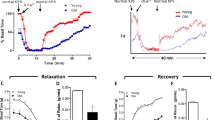Abstract
Inhibition of cGMP-specific phosphodiesterase type 5 (PDE5) has been shown to improve penile erection in patients with erectile dysfunction. We have reported previously the cloning of three PDE5 isoforms from human penile tissues. Here we report the cloning of two PDE5 isoforms from rat penile tissues. The similarity between rat and human PDE5A1-specific sequences were 68 and 88% at the nucleotide and amino-acid levels, respectively. Like the bovine and canine PDE5A1 sequences, the rat PDE5A1 sequence lacks the polyglutamine tract that appears to be unique to the human PDE5A1 sequence. The similarity between rat and human PDE5A2-specific sequences were 64 and 100% at the nucleotide and amino-acid levels, respectively. The equivalent of human PDE5A3-specific sequence was identified in the rat PDE5A gene; however, repeated efforts to clone the putative rat PDE5A3 isoform were not successful. Expression of PDE5A1 and A2 mRNA in various tissues was examined by Northern blotting and reverse transcription–polymerase chain reaction. Results from the two experimental procedures were largely in good agreement and indicated that PDE5A1 and A2 mRNA were expressed in a tissue-specific manner with PDE5A2 being the dominant isoform.
This is a preview of subscription content, access via your institution
Access options
Subscribe to this journal
Receive 8 print issues and online access
$259.00 per year
only $32.38 per issue
Buy this article
- Purchase on Springer Link
- Instant access to full article PDF
Prices may be subject to local taxes which are calculated during checkout






Similar content being viewed by others
References
Francis SH, Turko IV, Corbin JD . Cyclic nucleotide phosphodiesterases: relating structure and function. Prog Nucleic Acid Res Mol Biol 2001; 65: 1–52.
Soderling SH, Beavo JA . Regulation of cAMP and cGMP signaling: new phosphodiesterases and new functions. Curr Opin Cell Biol 2000; 12: 174–179.
Lin CS, Xin ZC, Lin G, Lue TF . Phosphodiesterases as therapeutic targets. Urology 2003; in press.
Küthe A et al. Expression of different phosphodiesterase genes in human cavernous smooth muscle. J Urol 2001; 165: 280–283.
Corbin JD, Francis SH, Webb DJ . Phosphodiesterase type 5 as a pharmacologic target in erectile dysfunction. Urology 2002; 60: 4–11.
Lin CS, Lau A, Tu R, Lue TF . Expression of three isoforms of cGMP-binding cGMP-specific phosphodiesterase (PDE5) in human penile cavernosum. Biochem Biophys Res Commun 2000; 268: 628–635.
Kotera J et al. Expression of rat cGMP-binding cGMP-specific phosphodiesterase mRNA in Purkinje cell layers during postnatal neuronal development. Eur J Biochem 1997; 249: 434–442.
Frohman MA, Dush MK, Martin GR . Rapid production of full-length cDNAs from rare transcripts: amplification using a single gene-specific oligonucleotide primer. Proc Natl Acad Sci USA 1988; 85: 8998–9002.
Thomson JM, Parrott WA . pMECA: a cloning plasmid with 44 unique restriction sites that allows selection of recombinants based on colony size. BioTechniques 1998; 24: 922–928.
Sanger F, Nicklen S, Coulson AR . DNA sequencing with chain-terminating inhibitors. Proc Natl Acad Sci USA 1977; 74: 5463–5467.
McAllister-Lucas LM et al. The structure of a bovine lung cGMP-binding, cGMP-specific phosphodiesterase deduced from a cDNA clone. J Biol Chem 1993; 268: 22 863–22 873.
Kotera J et al. Novel alternative splice variants of cGMP-binding cGMP-specific phosphodiesterase. J Biol Chem 1998; 273: 26 982–26 990.
Stacey P, Rulten S, Dapling A, Phillips SC . Molecular cloning and expression of human cGMP-binding cGMP-specific phosphodiesterase (PDE5). Biochem Biophys Res Commun 1998; 247: 249–254.
Loughney K et al. Isolation and characterization of cDNAs encoding PDE5A, a human cGMP-binding, cGMP-specific 3′,5′-cyclic nucleotide phosphodiesterase. Gene 1998; 216: 139–147.
Yanaka N et al. Expression, structure and chromosomal localization of the human cGMP-binding cGMP-specific phosphodiesterase PDE5A gene. Eur J Biochem 1998; 255: 391–399.
Freiman RN, Tjian R . Neurodegeneration. A glutamine-rich trail leads to transcription factors. Science 2002; 296: 2149–2150.
Piccioni F et al. Androgen receptor with elongated polyglutamine tract forms aggregates that alter axonal trafficking and mitochondrial distribution in motor neuronal processes. FASEB J 2002; 16: 1418–1420.
Acknowledgements
This work was supported in part by grants from the California Urology Foundation (to C-S Lin) and from NIH (2R01-DK-45370, to TF Lue).
Author information
Authors and Affiliations
Corresponding author
Rights and permissions
About this article
Cite this article
Lin, CS., Lin, G. & Lue, T. Isolation of two isoforms of phosphodiesterase 5 from rat penis. Int J Impot Res 15, 129–136 (2003). https://doi.org/10.1038/sj.ijir.3900983
Received:
Revised:
Accepted:
Published:
Issue Date:
DOI: https://doi.org/10.1038/sj.ijir.3900983
Keywords
This article is cited by
-
Direct androgen regulation of PDE5 gene or the lack thereof
International Journal of Impotence Research (2013)
-
Effect of icariin on cyclic GMP levels and on the mRNA expression of cGMP-binding cGMP-specific phosphodiesterase (PDE5) in penile cavernosum
Journal of Huazhong University of Science and Technology (2006)



